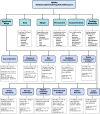Influence of Physicochemical Properties of Iron Oxide Nanoparticles on Their Antibacterial Activity
- PMID: 39130596
- PMCID: PMC11308002
- DOI: 10.1021/acsomega.4c02822
Influence of Physicochemical Properties of Iron Oxide Nanoparticles on Their Antibacterial Activity
Abstract
The increasing occurrence of infectious diseases caused by antimicrobial resistance organisms urged the necessity to develop more potent, selective, and safe antimicrobial agents. The unique magnetic and tunable properties of iron oxide nanoparticles (IONPs) make them a promising candidate for different theragnostic applications, including antimicrobial agents. Though IONPs act as a nonspecific antimicrobial agent, their antimicrobial activities are directly or indirectly linked with their synthesis methods, synthesizing precursors, size, shapes, concentration, and surface modifications. Alteration of these parameters could accelerate or decelerate the production of reactive oxygen species (ROS). An increase in ROS role production disrupts bacterial cell walls, cell membranes, alters major biomolecules (e.g., lipids, proteins, nucleic acids), and affects metabolic processes (e.g., Krebs cycle, fatty acid synthesis, ATP synthesis, glycolysis, and mitophagy). In this review, we will investigate the antibacterial activity of bare and surface-modified IONPs and the influence of physiochemical parameters on their antibacterial activity. Additionally, we will report the potential mechanism of IONPs' action in driving this antimicrobial activity.
© 2024 The Authors. Published by American Chemical Society.
Conflict of interest statement
The authors declare no competing financial interest.
Figures



Similar articles
-
Exploration of Metal-Doped Iron Oxide Nanoparticles as an Antimicrobial Agent: A Comprehensive Review.Cureus. 2024 Sep 16;16(9):e69556. doi: 10.7759/cureus.69556. eCollection 2024 Sep. Cureus. 2024. PMID: 39421116 Free PMC article. Review.
-
Iron Oxide Nanoparticles as Promising Antibacterial Agents of New Generation.Nanomaterials (Basel). 2024 Aug 3;14(15):1311. doi: 10.3390/nano14151311. Nanomaterials (Basel). 2024. PMID: 39120416 Free PMC article. Review.
-
The Promise of Metal-Doped Iron Oxide Nanoparticles as Antimicrobial Agent.ACS Omega. 2023 Dec 21;9(1):16-32. doi: 10.1021/acsomega.3c06323. eCollection 2024 Jan 9. ACS Omega. 2023. PMID: 38222657 Free PMC article. Review.
-
Do Iron Oxide Nanoparticles Have Significant Antibacterial Properties?Antibiotics (Basel). 2021 Jul 20;10(7):884. doi: 10.3390/antibiotics10070884. Antibiotics (Basel). 2021. PMID: 34356805 Free PMC article. Review.
-
Iron Oxide Nanoparticles: Green Synthesis and Their Antimicrobial Activity.Nanomaterials (Basel). 2023 Nov 8;13(22):2919. doi: 10.3390/nano13222919. Nanomaterials (Basel). 2023. PMID: 37999273 Free PMC article. Review.
Cited by
-
Green biosynthesis of titanium dioxide nanoparticles incorporated gellan gum hydrogel for biomedical application as wound dressing.Front Chem. 2025 Apr 17;13:1560213. doi: 10.3389/fchem.2025.1560213. eCollection 2025. Front Chem. 2025. PMID: 40313399 Free PMC article.
-
Beyond antibiotics: exploring multifaceted approaches to combat bacterial resistance in the modern era: a comprehensive review.Front Cell Infect Microbiol. 2025 Mar 18;15:1493915. doi: 10.3389/fcimb.2025.1493915. eCollection 2025. Front Cell Infect Microbiol. 2025. PMID: 40176987 Free PMC article. Review.
-
Enhanced Antimicrobial and Biofilm-Disrupting Properties of Gallium-Doped Carbon Dots.ACS Omega. 2025 Jun 20;10(25):27559-27574. doi: 10.1021/acsomega.5c03575. eCollection 2025 Jul 1. ACS Omega. 2025. PMID: 40621032 Free PMC article.
-
Magnetite-Assisted Capture Affinity, Concentration Dependence, and Magnetic Extraction Rate of Bacillus cereus.Microorganisms. 2025 May 22;13(6):1176. doi: 10.3390/microorganisms13061176. Microorganisms. 2025. PMID: 40572064 Free PMC article.
-
Chitosan and Its Nanoparticles: A Multifaceted Approach to Antibacterial Applications.Nanomaterials (Basel). 2025 Jan 16;15(2):126. doi: 10.3390/nano15020126. Nanomaterials (Basel). 2025. PMID: 39852740 Free PMC article. Review.
References
-
- Srakocic S.; Biggers A.. How Do Bacteria Become Resistant to Antibiotics? In Healthline, 2022.https://www.healthline.com/health/antibiotics/how-do-bacteria-become-res...
Publication types
LinkOut - more resources
Full Text Sources
Molecular Biology Databases
